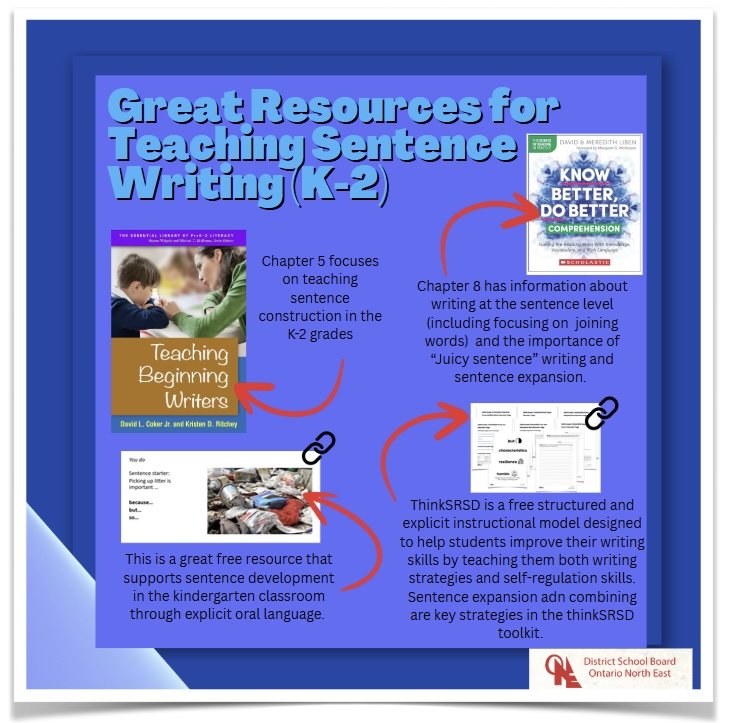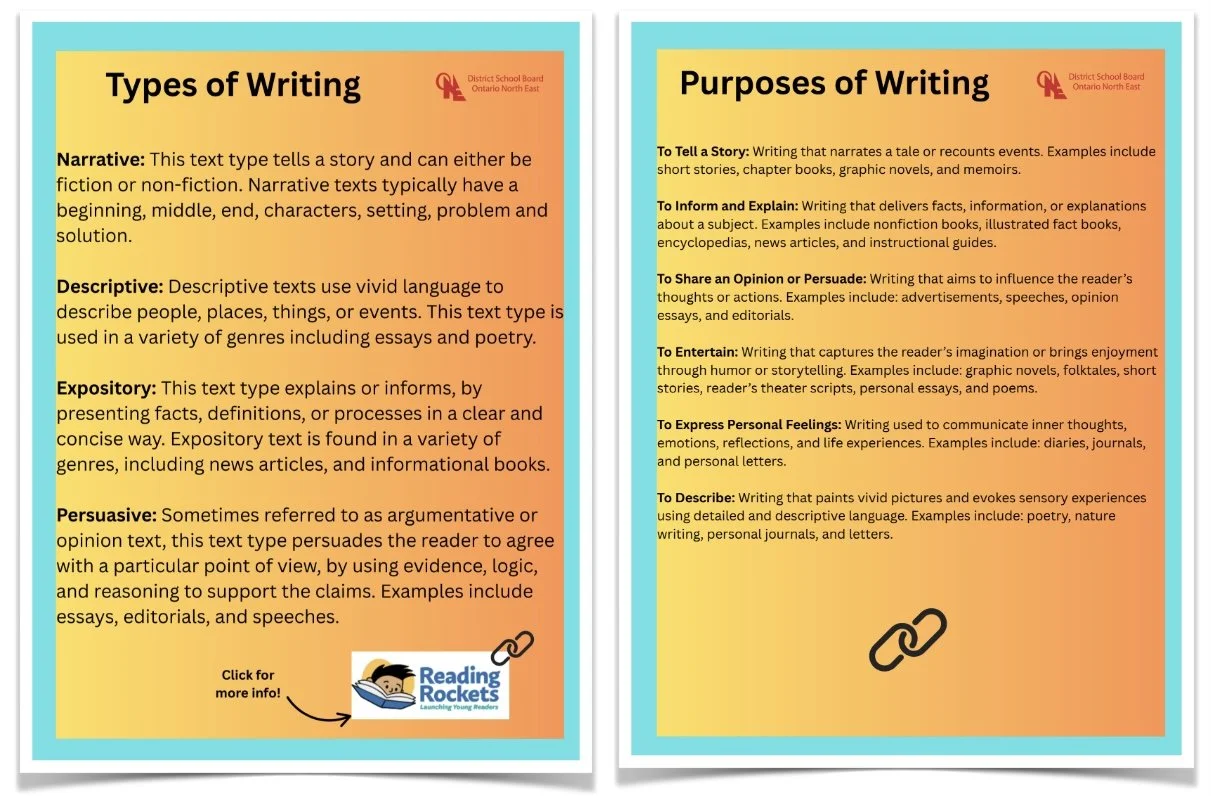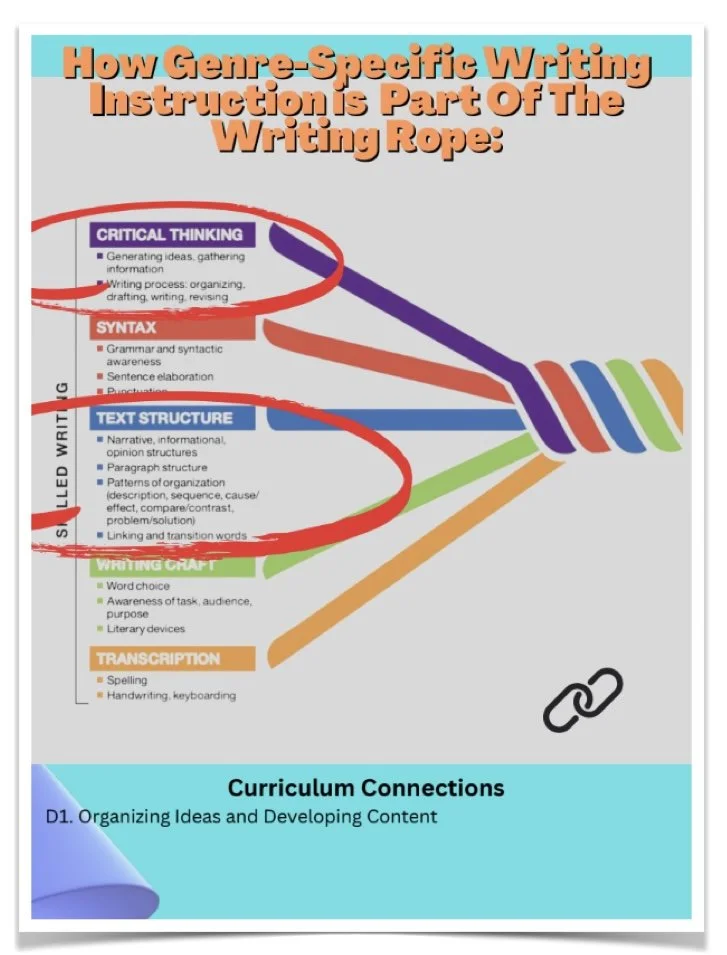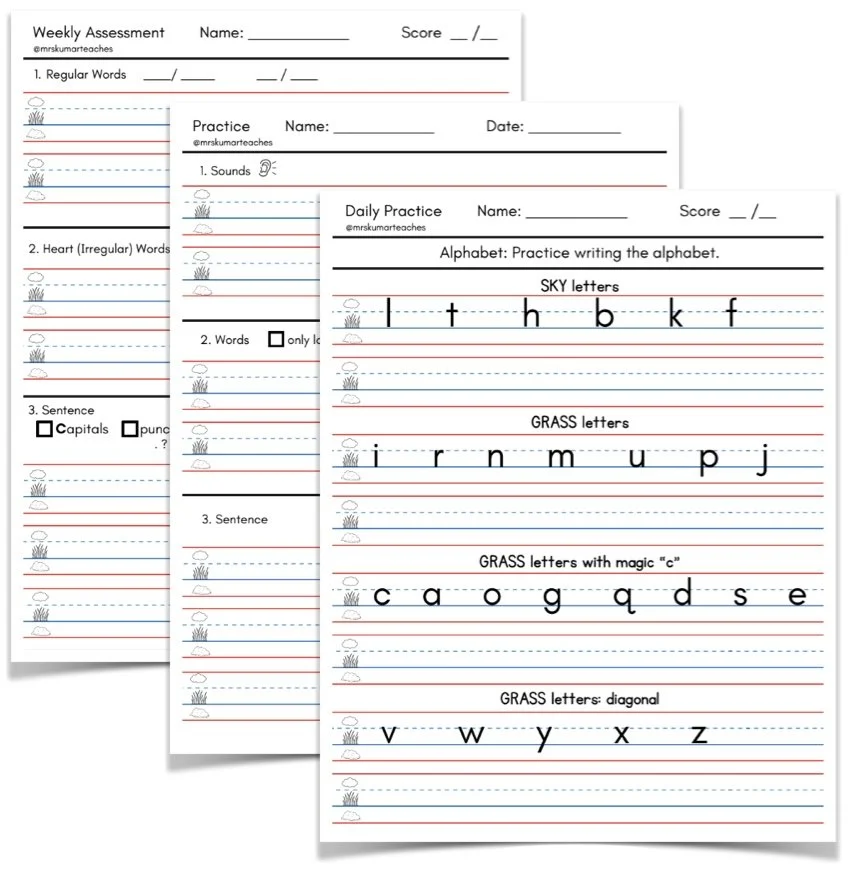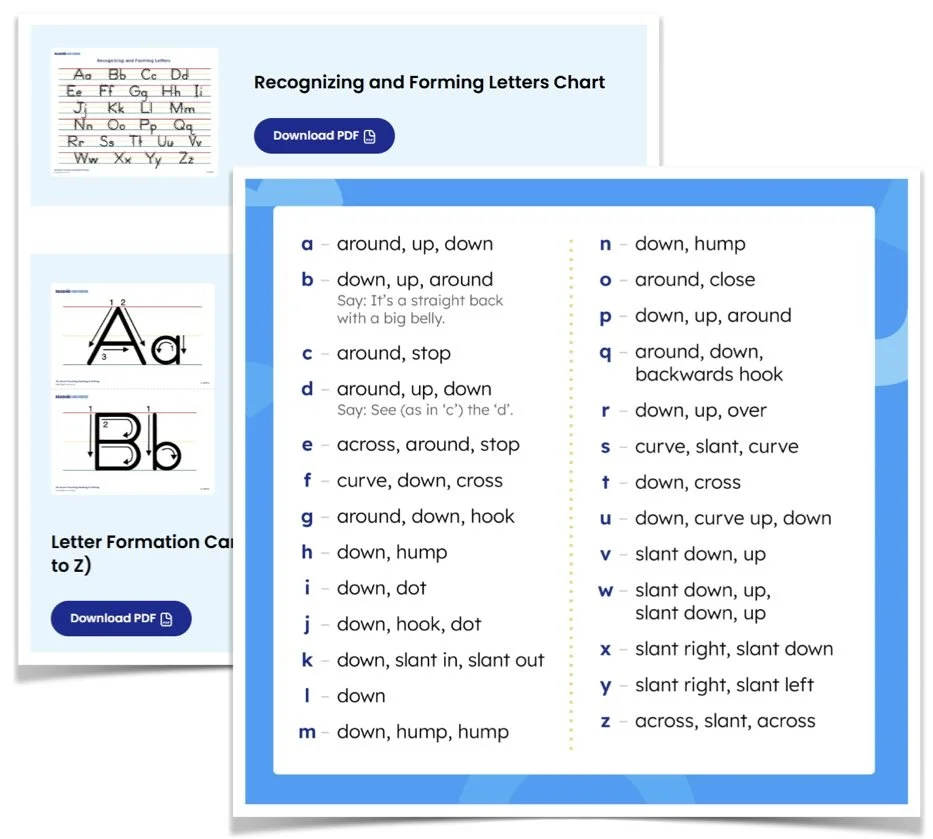Writing
The Writing Rope model, by Joan Sedita, incorporates the five components of a comprehensive writing program: Critical Thinking, Syntax, Text Structure, Writing Craft, and Transcription.
Inspired by Scarborough’s Reading Rope, it demonstrates that the writing skills within it are not taught in isolation, but are instead interwoven to support fluent, purposeful writing.
The sections below provide an overview as well as some resources for instruction and practice of the five components of The Writing Rope.
For more information about The Writing Rope, visit the
links to Reading Rockets and ONlit within this document.
Use these buttons for navigating to the sections below.
Grades 3 - 6
Word, Sentence, & Paragraph Modelling & Teaching
This section incorporates most and sometimes all areas of The Writing Rope. It offers an overview, examples, and links to resources for teaching word, sentence, and paragraph-level writing that can be adapted to all students learning to write.
Here is a great article that offers some practical examples that you can use in your classroom.
Related Curriculum Expectations:
D1. Developing Ideas and Organizing Content
D2. Creating Texts
D3. Publishing, Presenting, and Reflecting
This practical, step-by-step instructional guide supports K-2 teachers in delivering explicit word-level spelling instruction. It outlines the essential foundations—phonological, orthographic, and morphological knowledge—and provides teacher scripts, prompts, and resource links to support the teaching process.
Teachers can use the Word Level Writing Plan to effectively structure lessons ensuring that they address curriculum expectations, differentiate instruction for both regular and irregular words, and apply the skills through interactive writing and targeted practice.
Spelling Pattern Reference Sheet
Article Highlight & Related Resources
English has a reputation of being overly-complicated. It is complex, but there is a predictable structure! This reference sheet gives an overview of some of the “tendencies” in English that explain why words are spelled the way they are. Note that this chart is not designed to be used directly with students – its purpose is to support educator knowledge.
Article: How Words Cast their Spell—Spelling Is an Integral Part of Learning the Language, Not a Matter of Memorization.
Research shows that spelling, reading, and writing are deeply connected, and that most words follow predictable patterns. Effective literacy depends on explicit spelling instruction. Click the image for some highlights or to access the full article about the importance of explicit and systematic spelling instruction in helping students become fluent readers, confident writers, and stronger thinkers.
These resources explain how spelling, reading, and writing are connected and why explicit spelling instruction is essential for literacy success, shifting the focus from rote memorization to understanding how words work.
By guiding instruction to focus on sounds, word parts, and structure, purposeful dictations help students build confidence and strengthen overall literacy skills.
Click the images for more information and practical suggestions.
This word-level spelling continuum outlines the progression of spelling knowledge from Kindergarten to Grade 3 as it connects to the Ontario Language Curriculum expectations.
Below are examples of word-level writing instruction by division (K-2 and 3-6). These documents highlight some of the programs that support writing such as Catch Up Your Code, Bug Club Morphology, Je sais lire, UFLI, and more!
Click each image for more information and to access some helpful links.
Grades K - 2
Grades K-2 Strategies
Check out this resource for a scaffolded approach to teaching K-2 students how to generate sentences.
It begins with having students learn what a sentence is and how to generate a sentence through oral routines. It then moves to co-writing and eventually to independent writing.
This resource provides links to instructional tools that support sentence writing in grades 3-6 using sentence types/parts of speech, combining sentences, expanding sentences, and more!
Click here for more great resources to support the instruction of sentence writing in K-2 classrooms.
Grades 3-6 Strategies
This resource provides ideas and links for teaching compositions. It includes generating a thesis, supporting details, and a conclusion. Transition words and phrases are featured during the revision process.
Click here for some ideas and links to resources that support paragraph writing, including planning with an outline, a topic sentence, supporting sentences, a concluding sentence, and revising and editing.
Single Paragraph Writing Strategies
Composition (Multiple Paragraphs) Writing Strategies
Gr. 3 Paragraph Writing
This resource provides lessons and practice for writing paragraphs in Grade 3. It includes some mini-lessons on parts of speech, punctuation, and persuasive writing.
Genre & Text-Level Writing
In this section, you will find resources with links pertaining to the different types and purposes of writing, genre-specific writing instruction, how to use mentor texts to improve writing skills, and how each is part of The Writing Rope.
Related Curriculum Expectations:
D1. Developing Ideas and Organizing Content
D2. Creating Texts
D3. Publishing, Presenting, and Reflecting
The resources in the Grade 3 & Grade 6 sections below provide learning goals with success criteria, mini-lessons, discussion prompts, shared activities, text-specific vocabulary, writing prompts, checklists, and more! They are presented in the form of slides and each focuses on a different writing type.
Gr. 6 Script Writing
Writing Book Reviews
This resource is based on chapter 7 “Teaching Students to Write Book Reviews” from the book Teaching Beginning Writers by David L. Coker Jr. and Kristen D. Ritchey.
It guides educators through the process of teaching about book reviews in phases (i.e. learning about book reviews, learning to evaluate book reviews, and learning to write book reviews) from Kindergarten to Grade 2.
Related Curriculum Expectations:
D1. Developing Ideas and Organizing Content
D2. Creating Texts
Gr. 3 Recount Writing
Gr. 6 Letter Writing (Friendly & Formal)
Mentor Texts
Gr. 3 Procedural Writing
Gr. 6 Report Writing
Gr. 3 Persuasive Writing
Gr. 6 Persuasive Writing
Writing Types & Purposes
Genre-Specific Writing Instruction
Gr. 3 Paragraph Writing
Printing, Handwriting, & Keyboarding Instructional Support & Resources
In this section you will find links to videos and articles that explain the “why” and the “how” of teaching printing and handwriting skills. This section also contains practical, ready-to-use resources that support the development and instruction of printing and handwriting skills.
“While neatness may aid in legibility, the primary goal of handwriting instruction is not teaching students to write beautifully or “neatly” or to have a grade of A+ in penmanship. The goal is to develop fluency.”
-”Teaching Beginning Writers by David L. Coker Jr. and Kristen D. Ritcher (p 28)
These skills are part of the “Transcription” area of The Writing Rope.
Related Curriculum Expectations:
Grade 1: D2.2 -print letters and words with appropriate formation patterns, size, placement, and spacing
Grade 2: D2.2 -print legibly and fluently, with appropriate formation patterns, size, placement, and spacing
Grade 3: D2.2 -begin to write in cursive, forming letters with appropriate formation patterns, size, placement, and spacing
Grade 4: D2.2 -write in cursive, forming letters of appropriate shape, size, proportion, and slant to improve the legibility of texts, and begin to develop fluent keyboarding skills using touch-typing techniques
Grade 5: D2.2 -write in fluent cursive, begin to keyboard with automaticity, and apply word-processing skills, including selecting appropriate fonts, to produce and enhance texts of various lengths
Grade 6: D2.2 -write in fluent cursive, and apply keyboarding skills with increasing fluency, automaticity, and proficiency to improve the accuracy and effect of texts
Below are links for ready-to-use resources that support printing skills. They are also available on this convenient, one-page infographic.
Provides links to downloadable resources such as desk plates, letter formation cards, and more!
Additional Resources About Printing Practice (Articles & Videos)
Available in English & French
Includes instructions, printable worksheets for French & English, posters, and more!
Weekly practice and assessment pages
Printing Practice Overview (K-3)
Handwriting Practice
English Handwriting Resources
French Handwriting Resources
Includes animated slides for modeling letter formation
ThinkSRSD- Systematic & Explicit Model for Writing Instruction
ThinkSRSD, or Self-Regulated Strategy Development, is a structured and explicit instructional model to help students improve their writing by teaching them both writing strategies and self-regulation skills.
The SRSD approach focuses on providing students with clear and simple strategies to support their writing while also building in opportunities for them to plan, monitor, and evaluate their progress as they write.
The thinkSRSD website offers a variety of free digital/printable resources such as mentor texts, writing prompts, graphic organizers, exemplars, goal-setting prompts, scoring guidelines, instructional videos, and more!
It is part of multiple areas of The Writing Rope.
Related Curriculum Expectations:
D1. Developing Ideas and Organizing Content
D2. Creating Texts
D3. Publishing, Presenting, and Reflecting
ThinkSRSD Overview
Grade 3 ThinkSRSD-Inspired POWeR Cycles
Check it out! This resource features a collection of thinkSRSD-inspired POWeR (Plan, Organize, Write, Revise) cycles designed specifically for grade 3 writers. Each cycle supports students in becoming strategic writers through explicit instruction in key strategies, with built-in opportunities to connect writing instruction to grade 3 content areas.
This resource helps to bridge Language curriculum expectations with other content areas such as Social Studies and Science. You will find mentor texts, links to additional texts to support the building of background knowledge, related vocabulary cards, content curriculum expectations, writing prompts, and more!
The thinkSRSD Guide (click here) provides a scope and sequence for the grade 3 provided resources as well as how to use the POWeR Cycles in the classroom; but they can be modified to suit your long-range plans.
ThinkSRSD Resources
Available in English & in French
*Stay tuned for additional thinkSRSD grade resources to be added to ONlit!
Back to:



















